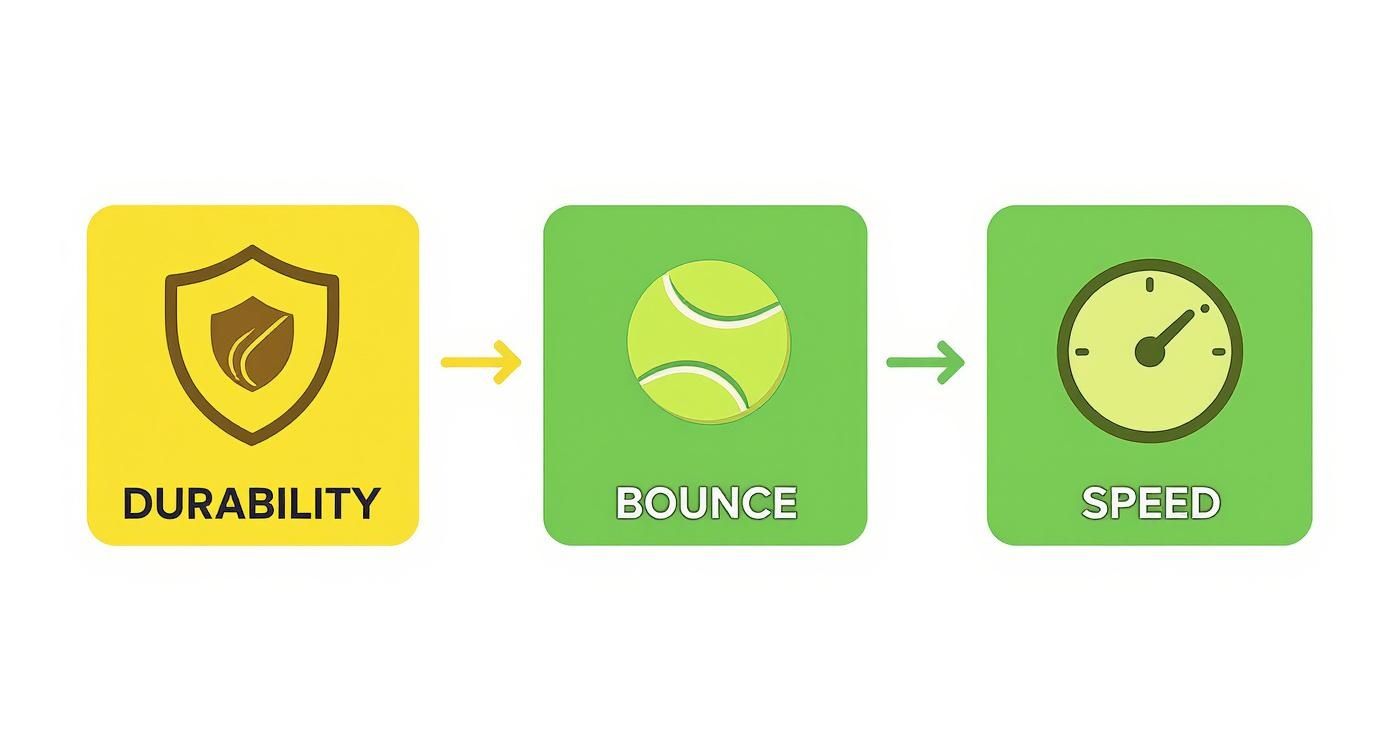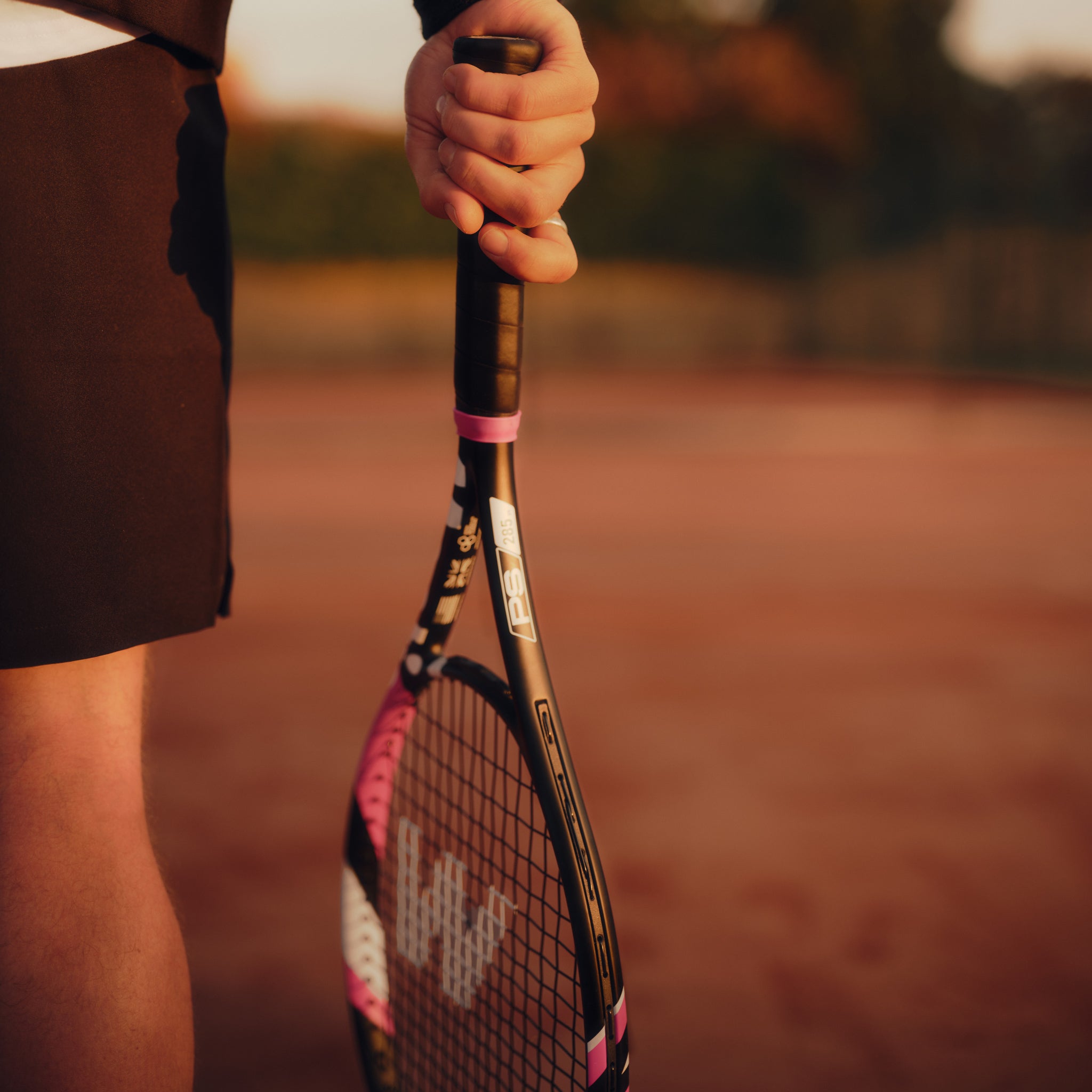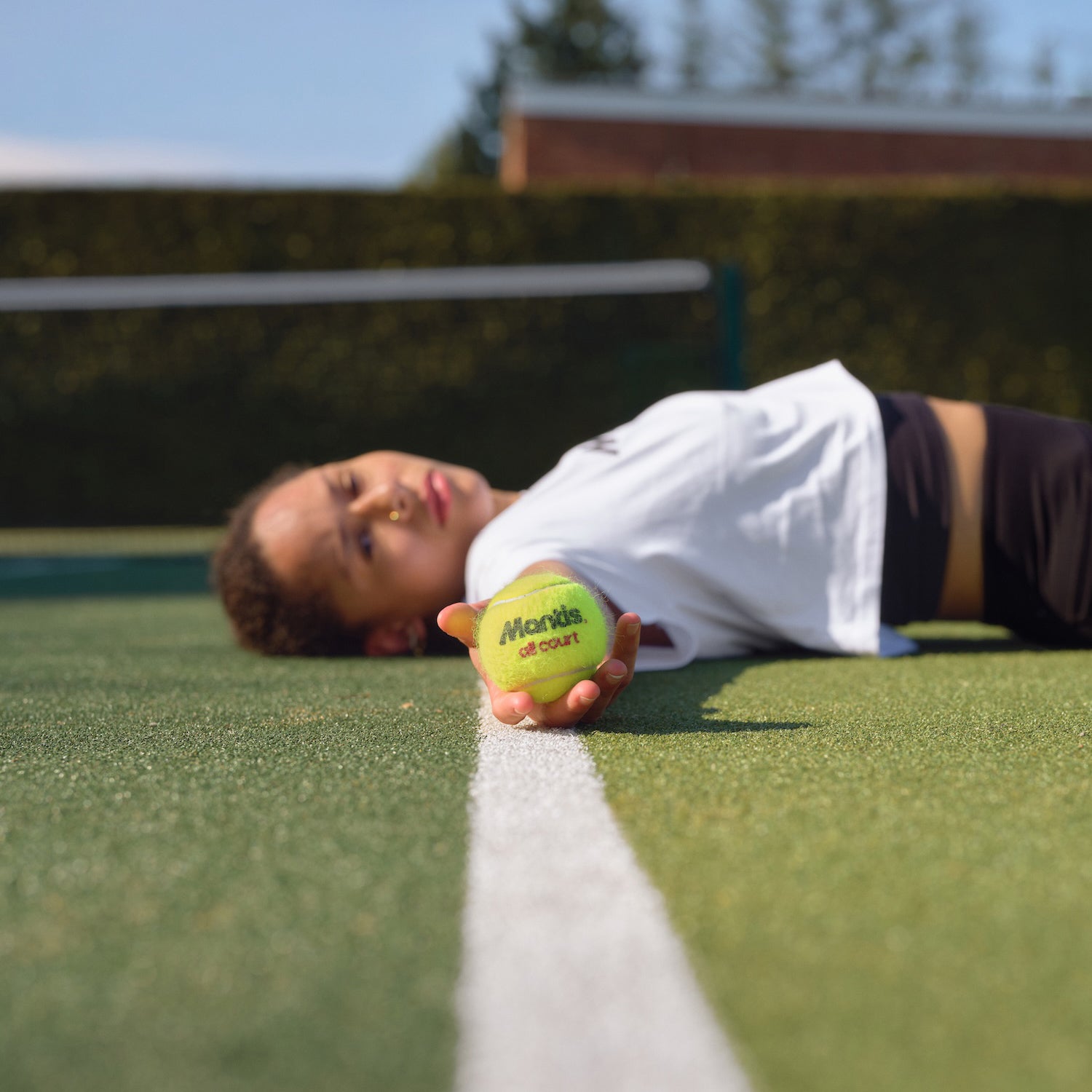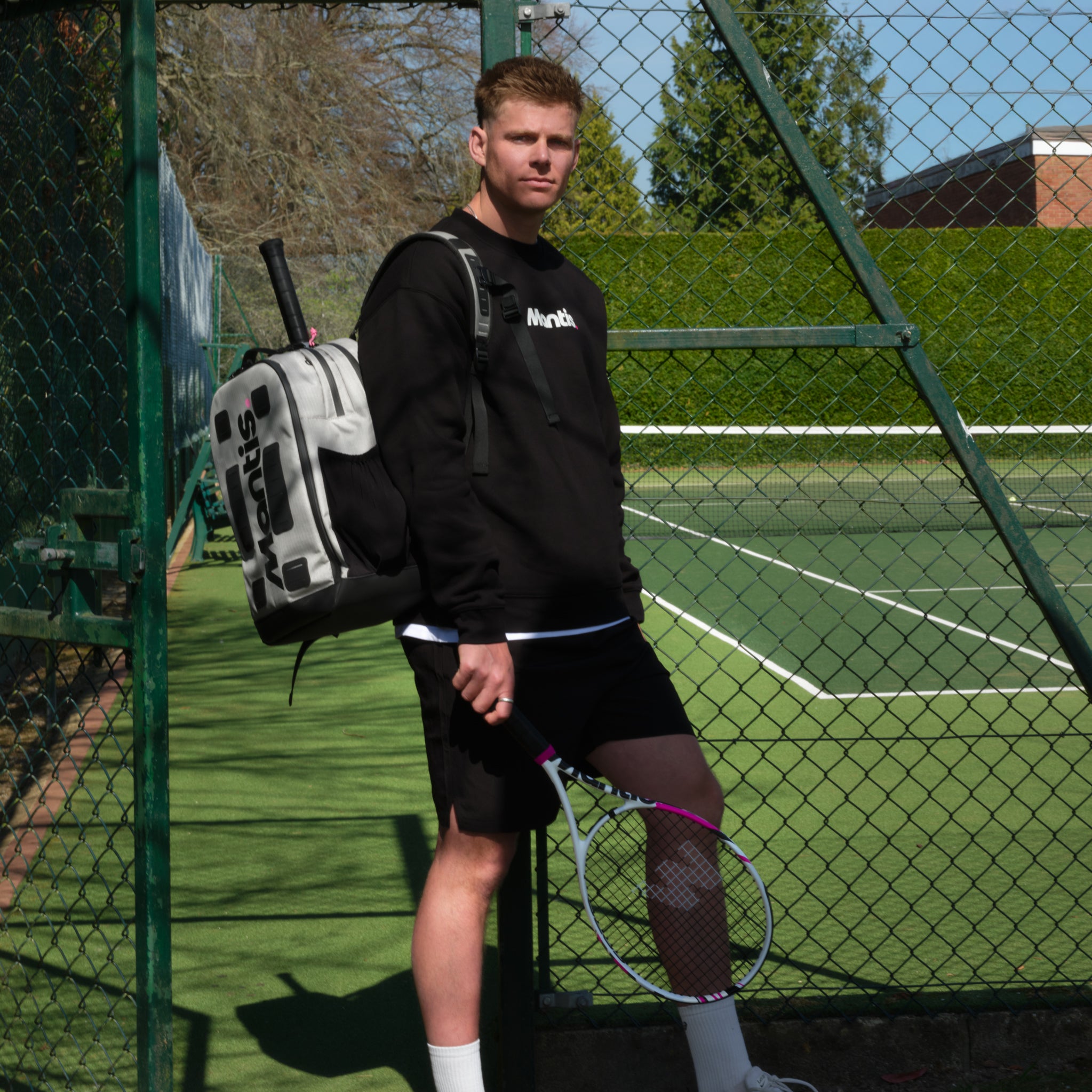
When you're playing on a hard court, choosing the right tennis ball isn't just a minor detail—it's a game-changer. For players looking for the best tennis balls for hard court matches, nothing matters more than durability. The best options are built with extra-duty felt and a reinforced rubber core, made specifically to take a beating on unforgiving surfaces. For a deeper understanding of how courts affect equipment, check out our guide on different tennis court surfaces.
At Mantis, we know that the right ball is just as important as the right racket. It’s what ensures consistent play from the first serve right through to the final point.
Choice Matters For The Best Tennis Balls for Hard Court
Hard courts are notoriously tough on tennis gear, and they chew through tennis balls like nothing else. Unlike the soft slide of clay or the slick speed of grass, a hard court’s gritty surface acts like sandpaper. It shreds a ball’s felt and kills its bounce in no time.
Picking a ball designed for this environment isn't just a preference; it’s essential if you want a consistent, enjoyable game. We know players invest in quality gear, and understanding how different tennis court surfaces impact your equipment is a huge part of that.
The biggest challenge is abrasion. A standard ball will turn fluffy and slow after just a few games, making it unpredictable and hard to control. Even worse, it loses its internal pressure much faster, leading to a dead, unsatisfying bounce that throws off your timing and rhythm completely.
Key Characteristics of a Great Hard Court Ball
So, what separates a top-tier hard court ball from one that’s useless after a couple of sets? It all comes down to its construction. At Mantis, we obsess over the small details that make a big difference on the court. The best balls for this surface all share a few key features that every player should learn to spot.
These elements work in harmony to create a ball that not only lasts longer but also delivers a predictable and reliable playing experience.
- Superior Durability: This comes from extra-duty felt, which has a much tighter weave and more synthetic fibres to stand up to friction.
- Consistent Bounce: A high-quality, thicker rubber core holds its internal pressure for longer, giving you a lively and predictable rebound every time.
- Predictable Speed: The durable felt stops the ball from fluffing up too much, allowing it to keep its shape and fly through the air at a consistent pace.
A well-made hard court ball is like a good sparring partner—it’s reliable, consistent, and pushes you to play your best without giving up too early.
To get a bit more technical, industry resources like racketbusiness.com offer great deep dives into equipment manufacturing. But for most players, simply understanding these core features is enough to make a smarter choice.
Choosing the right ball means you'll spend less time cracking open new cans and more time focused on hitting your shots. A durable ball gives you better value and, more importantly, a better game.
To make things even clearer, here’s a quick summary of what to look for.
Hard Court Tennis Ball Characteristics at a Glance
This table breaks down the essential features of a great hard court tennis ball and explains exactly why they matter for your game.
| Characteristic | Why It Matters on Hard Courts | What to Look For |
|---|---|---|
| Felt Type | The abrasive surface quickly wears down standard felt, causing fluffing and inconsistent flight. | Extra-duty felt with a higher wool and synthetic fibre content to resist wear and tear. |
| Core Construction | Constant impact on a hard surface causes the ball to lose pressure faster, resulting in a dead bounce. | A thicker, high-quality rubber core that’s better at maintaining internal pressure over time. |
| Seam Durability | The seams are a weak point and can split or fray under the stress of hard court play. | Reinforced, durable seams that are less likely to come apart after a few hard-hitting sets. |
| Visibility | Good visibility is crucial for tracking the ball at speed against the court and its surroundings. | Bright, optic yellow felt that stands out clearly, especially under lights or in low sun. |
Ultimately, paying attention to these details will ensure the balls you choose can keep up with the demands of the court and your game.
Breaking Down the Hard Court Tennis Ball
What really makes a tennis ball tough enough for the unforgiving surface of a hard court? To get to the heart of it, you have to look inside. The engineering that goes into a high-performance ball is all about two key parts working together: the internal rubber core and the external felt cover. For a great deep dive into the manufacturing side, Mantis has a guide on how tennis balls are made that adds some excellent context.
Think of the core like the suspension on a car. It needs to be rugged enough to handle constant, high-speed impacts but still provide that lively, predictable response players count on. This is where a ball’s bounce and longevity are born.
The Heart of the Matter: The Rubber Core
The rubber core is the engine room of a tennis ball. It’s what directly controls both its bounce and how long it will last. This isn’t just any old rubber; manufacturers use a precise blend of natural rubber and other chemicals to strike the perfect balance between elasticity and strength. For hard court balls, the thickness of this core is everything.
A thicker core is better at holding its internal pressure. Every single time the ball smacks against that abrasive court surface, a minuscule amount of air escapes. After hundreds of hits, this adds up and you get a "dead" ball. A more robust core slows that process way down, keeping the ball’s bounce consistent for more sets. It’s the quality control in the rubber mixture that separates a premium ball from one that gives up after a few games.
This visual shows the three pillars that support a top-tier hard court tennis ball.

As you can see, durability, bounce, and speed are all tangled together, defining how a ball will stand up to the demands of a hard court.
The Protective Outer Layer: The Felt
While the core gives the ball its bounce, the felt is all about feel, control, and fighting off wear and tear. The felt used on the best tennis balls for hard court play is known as extra-duty felt, which is a special mix of natural wool and synthetic nylon fibres. This blend is crucial for surviving the court's sandpaper-like texture.
A ball’s felt acts like the tread on a tyre. Natural wool provides the grip and feel for generating spin, while the synthetic fibres add the toughness needed to prevent it from wearing out too quickly.
On hard courts, the felt is under constant attack. A lower-quality felt will "fluff up," catching more air, which slows the ball down dramatically and makes it feel less responsive off the strings. In contrast, a tightly woven, durable felt keeps its streamlined profile, giving you predictable speed and spin potential throughout the match.
Understanding this anatomy helps you see past the marketing hype and spot the signs of a well-made ball that’s built specifically for hard court play.
How to Measure Durability and Felt Lifespan
When you're looking for the best tennis balls for hard court play, one thing matters more than anything else: durability. At Mantis, we know a ball’s lifespan has a massive impact on the quality of a match, which is why resilience is at the core of our designs. After all, the number one complaint about playing on abrasive surfaces is how quickly a ball can lose its felt and go ‘dead’, turning a lively game into a frustrating slog. For a look at the technical side, our guide on how tennis balls are made is a great resource.
The secret to a long-lasting hard court ball lies in a term you’ll often spot on the can: ‘extra duty’ felt. This isn’t just a marketing slogan. It describes a thicker, more robust felt covering with interlocking fibres, specifically engineered to take a beating. Think of it as the difference between a standard t-shirt and a heavy-duty work jacket—one is made for comfort, the other for punishment.
This specialised felt is designed to fight back against the sandpaper-like effect of the court, helping the ball keep its aerodynamic shape and stopping it from fluffing up too soon.
What to Look and Listen For
So, how do you tell if a ball is on its last legs without needing a science degree? There are a few practical clues you can pick up on, both by looking at the ball and feeling it in play. Learning these signs will help you know exactly when it’s time to pop open a fresh can.
A quick visual check is the best place to start. Take a close look at the felt. Is it still smooth and tight, or has it started to ‘fluff up’? A fluffed-up ball has lost its integrity, creating more drag and slowing it down through the air. You should also check the seams for any signs of fraying or pulling apart.
But it’s the feel of the ball during a rally that often tells the real story. A ball that’s nearing the end of its life just feels different coming off the strings.
- Loss of 'Bite': You might notice you’re not getting the same spin or purchase on your shots. The worn-down felt simply can't grip the strings as effectively.
- Change in Sound: Listen for the sound at impact. A fresh, pressurised ball makes a distinct, crisp ‘pop’. In contrast, a worn-out one produces a dull, heavy thud.
- Inconsistent Bounce: This is the most obvious sign. If the ball isn't bouncing back to a consistent height, its core has lost too much pressure to be useful.
The moment a ball starts feeling heavy or sluggish off the racket, it's past its prime. Pushing on with a dead ball doesn't just lower the quality of the match; it can lead to bad habits as you start overcompensating with your swing.
UK Player Preferences and Lifespan
Research from the LTA shows what UK players really want from their tennis balls. In a 2023 survey, 68% of club players and coaches in the UK said they preferred balls with higher felt density and a reinforced core designed for hard courts. These extra-duty balls typically last for 6 to 8 hours of solid play on hard surfaces before they need replacing, compared to just 4 to 6 hours on softer courts like clay or grass.
Finding the Sweet Spot: Bounce, Speed, and Control
A great tennis ball is more than just durable; it has to feel right when the pressure is on. While toughness keeps a ball in play longer, it's that delicate sweet spot between bounce, speed, and control that really separates the best tennis balls for hard courts from the rest. At Mantis, we know that a predictable ball builds confidence, which is why we're obsessed with the performance details that lead to better shot-making. When you trust how a ball will react, you can trust your technique—a philosophy we dive into in our guide on how tennis balls are made.
The engine behind a great bounce is internal pressure. Think of it like a car tyre—the more air inside, the firmer and more responsive the ride. A well-pressurised ball gives you that lively, consistent rebound off the hard court, letting you find your rhythm and time your groundstrokes perfectly.
For any serious player, this predictability is everything. A ball that bounces to the same height every time lets you set up for your shots with complete confidence, knowing exactly where it’s going to be at the point of contact. When a ball feels like a finely tuned instrument in your hands, you gain the control to execute your game plan, whether that’s a heavy topspin forehand or a cheeky drop shot.
Matching Ball Speed to Your Game
A ball's speed comes down to two things: its internal pressure and the state of its felt. A fresh, highly pressurised ball with smooth felt will zip through the air, giving aggressive, attack-minded players the upper hand. That extra pace helps them hit winners and keep their opponents scrambling.
On the other hand, as a ball’s felt fluffs up and it loses a bit of pressure, it naturally slows down. This can actually be a good thing for baseline players who build their game around long rallies and heavy topspin. A slightly slower ball buys them that extra split second to prepare and construct points with more strategy.
The key takeaway here is that consistency isn't just about bounce height; it's about predictable speed. The best hard court balls hold onto their speed characteristics for much longer, so you don't get that frustrating drop-off that turns a fast-paced match into a slow-motion grind.
The Science of a Consistent Bounce
The link between bounce and control isn't just a feeling; it's measurable. Research from the LTA on ball performance across UK hard courts found that balls with a higher compression rating, typically between 55-60 lbs, provided the most consistent bounce and speed. This isn't just about fair play—it’s also a safety issue, as it cuts down on the weird, unpredictable bounces that can cause awkward movements and injuries.
The same study also revealed that 74% of UK hard court players felt they had better control and a lower injury risk when using balls made specifically for these surfaces.
Ultimately, choosing a ball that complements your playing style—whether you need a higher bounce for baseline battles or more pace for attacking the net—is a simple but powerful step towards playing your best tennis on a hard court.
Pressurized vs Pressureless Balls on Hard Courts
Choosing between pressurised and pressureless balls is one of the biggest decisions a player makes, and the debate is especially fierce on hard courts. At Mantis, we think understanding this choice is fundamental to improving your game. We often get into the technical side of things, like in our guide on how tennis balls are made, but here, we’ll cut straight to what you need to know.
Pressurised balls are what you see in the pro game, and for good reason. When you crack open a fresh can, you get that satisfying ‘pop,’ a lively bounce, and the kind of spin potential that competitive players rely on. Their hollow core is filled with pressurised air, which gives them a responsive, crisp feel that’s perfect for match play.
But their greatest strength is also their biggest weakness. All that internal pressure starts to escape over time, a process that’s sped up by the constant, heavy impact on an unforgiving hard court. This means their peak performance is short-lived; after just a few hours of intense play, they can start to feel heavy, dead, and disappointing.
The Durable Alternative for Practice
On the other side of the net, you’ll find pressureless balls. These get their bounce from a solid, firm rubber core, not from internal air pressure. Think of them as the marathon runners of the tennis world. They don't have the explosive sprint of a pressurised ball, but their endurance is simply unmatched.
Because they don’t rely on pressure, they never "go flat." Their bounce stays consistent for months, making them a brilliant, cost-effective choice for coaching, long practice sessions, or filling up a ball machine. For anyone wanting to dig deeper into the manufacturing and longevity of tennis gear, industry resources like racketbusiness.com offer some fantastic analysis.
The trade-off? Feel. Pressureless balls are typically heavier and firmer. They offer less spin and have a distinctly different sound on impact, which is why they’re the champions of the practice court but sit on the sidelines during professional tournaments.
Making the Right Choice for Your Game
So, which one is right for you? It really boils down to what you’re doing on the court. Are you playing a competitive match where every bit of feel and responsiveness matters? Or are you drilling for hours and just need a ball that can keep up with you?
To make it even clearer, let's break down the key differences head-to-head.
Pressurized vs Pressureless Tennis Balls for Hard Courts
This table offers a direct comparison to help you decide which ball best suits your needs on hard court surfaces.
| Feature | Pressurized Balls | Pressureless Balls |
|---|---|---|
| Best For | Competitive matches, tournament play | Practice, coaching, ball machines |
| Lifespan | Short (a few hours of peak play) | Very long (months of consistent use) |
| Feel & Performance | Lively, high spin, responsive feel | Firmer, heavier, less spin potential |
| Bounce | High and consistent when new | Consistent but often lower and heavier |
| Cost | Lower per can, but replaced frequently | Higher initial cost, but better long-term value |
Ultimately, many players use both. They'll fill their basket with durable pressureless balls for practice and save the fresh cans of pressurised balls for match day. It’s a practical approach that gives you the best of both worlds without breaking the bank.
Your Hard Court Tennis Ball Questions Answered
Choosing the right tennis ball can feel like a small detail, but on a hard court, it makes all the difference. We get a lot of questions from players trying to get the most out of their gear, so we've put together some straight answers to the most common queries. And if you want to go a little deeper on how surfaces change the game, our guide on how different tennis court surfaces is a great place to start. For now, let’s clear up a few things.
How Often Should I Change Tennis Balls on a Hard Court?
In a competitive match, the answer is simple: crack open a new can every time. Most tournaments even change balls every 9 to 12 games to keep the bounce and feel consistent.
For a friendly hit or practice, you can be more relaxed. The best guide is your own feel for the ball. Does the bounce feel weak? Is the felt looking more like a sad, fluffy kitten than a tennis ball? If so, it's time for a fresh set.
A quick test: drop a ball from shoulder height. If it doesn’t make it back up to your waist, the internal pressure is gone. On a gritty hard court, you can expect a good quality pressurised ball to last about 6 to 8 hours of decent play before it's ready to be retired to the dog park.
Are Extra Duty Balls Really Better for Hard Courts?
Yes, one hundred percent. This isn't just marketing fluff. 'Extra Duty' balls are built specifically for the unforgiving nature of hard courts.
They’re made with a thicker, tougher felt that has more synthetic fibres woven in. This extra resilience helps the ball stand up to the constant grinding against the court surface, preventing it from fluffing up too quickly and wearing out.
While 'Regular Duty' balls are perfect for softer clay courts, they'll get chewed up on a hard court in no time. Stick with 'Extra Duty' for a ball that plays consistently from the first serve to the last.
Using the right ball for the surface is non-negotiable for consistent play. Extra duty felt on a hard court is the equivalent of using the right tyres for the road conditions—it provides the grip, durability, and performance you need to stay in control.
Can I Use High Altitude Balls on Standard Hard Courts?
We really wouldn't recommend it. High-altitude balls are designed with lower internal pressure to compensate for the thinner air you find at higher elevations. This stops them from bouncing over your head or flying off your strings.
Bring those balls down to sea level, and they’ll feel dead. The bounce will be sluggish and low, completely throwing off your timing and rhythm. Unless you’re playing somewhere above 4,000 feet (around 1,220 metres), always use standard balls. It’s the only way to get a true, reliable feel for your shots.
At Mantis, we live for the game. We’re committed to making equipment that helps dedicated players perform at their best. From our precision-engineered rackets to our hard-wearing tennis balls, every product is built for reliability. See the full range of tennis equipment at https://mantissport.com.








